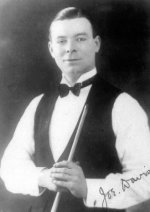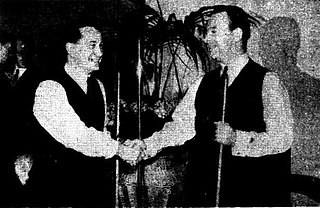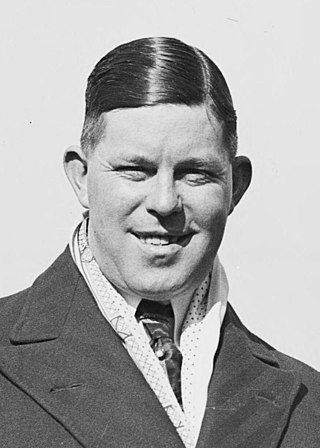
Joseph Davis was an English professional snooker and English billiards player. He was the dominant figure in snooker from the 1920s to the 1950s, and has been credited with inventing aspects of the way the game is now played, such as break-building. With the help of equipment manufacturer Bill Camkin, he drove the creation of the World Snooker Championship by persuading the Billiards Association and Control Council to recognise an official professional snooker championship in 1927. Davis won the first 15 world championships from 1927 to 1946, and he is the only undefeated player in World Snooker Championship history. In 1930, he scored the championship's first century break.
Desmond Rex Williams is a retired English professional snooker and billiards player. He was the second player to make an official maximum break, achieving this in an exhibition match in December 1965. Williams won the World Professional Billiards Championship from Clark McConachy in 1968, the first time that the title had been contested since 1951. Williams retained the title in several challenge matches in the 1970s, and, after losing it to Fred Davis in 1980, regained it from 1982 to 1983.

Walter Weir Wilson Donaldson was a Scottish professional snooker and billiards player. He contested eight consecutive world championship finals against Fred Davis from 1947 to 1954, and won the title in 1947 and 1950. Donaldson was known for his long potting and his consistency when playing, and had an aversion to the use of side. In 2012, he was inducted posthumously into the World Professional Billiards and Snooker Association's World Snooker Hall of Fame.

Horace Lindrum was an Australian professional snooker and billiards player. Lindrum won the 1952 World Snooker Championship defeating New Zealander Clark McConachy. The tournament is disputed, as it had only two participants, and other players boycotted the event to play in the 1952 World Professional Match-play Championship. Lindrum won the Australian Professional Billiards Championship on multiple occasions, first winning the event in 1934.
The 1927 World Snooker Championship was a snooker tournament held at various venues from 29 November 1926 to 12 May 1927. At the time, it was titled the Professional Championship of Snooker but it is now recognised as the inaugural edition of the World Snooker Championship. The impetus for the championship came from professional English billiards player Joe Davis and billiard hall manager Bill Camkin, who had both observed the growing popularity of snooker, and proposed the event to the Billiards Association and Control Council. Ten players entered the competition, including most of the leading billiards players. The two matches in the preliminary round were held at Thurston's Hall in London, and the semi-finals final took place at Camkin's Hall in Birmingham. The players involved determined the venues for the quarter-finals, resulting in one match being held at Thurston's Hall, one at Camkin's Hall, and one each in Nottingham and Liverpool.

Walter Albert Lindrum, OBE, often known as Wally Lindrum, was an Australian professional player of English billiards who held the World Professional Billiards Championship from 1933 until his retirement in 1950. Being the first Lindrum born in Western Australia, he was named Walter Albert to have the initials of the state where he was born. He was one of the most successful players ever seen in billiards, with 57 world records to his credit, some of which still stand.
The 1969 World Snooker Championship was a professional snooker tournament. It was the first World Snooker Championship in a knock-out format since 1957, following a series of challenge matches from 1964 to 1968. John Spencer won the title, defeating Gary Owen by achieving a winning margin at 37 frames to 24 in the final. Spencer had earlier eliminated defending champion John Pulman from the competition, in the quarter-finals.
The 1970 World Snooker Championship was a professional snooker tournament that took place from 15 October 1969 to 11 April 1970, as an edition of the World Snooker Championship. The final was held at Victoria Hall in London from 6 to 11 April 1970. For the second and last time the event was sponsored by Player's No.6.

Tom Reece was an English professional player of English billiards. He was six times runner-up in the professional billiards championship, now regarded as the world championship, losing three times to Melbourne Inman in finals from 1912 to 1914, and three times to Tom Newman in the 1921, 1924 and 1925 finals. He made the unofficial world's highest billiards break of 499,135 in 1907 using a cradle cannon technique shortly before it was banned from the sport. In 1927, his prowess with the pendulum stroke led to that also being banned from use in competition.
The 1929 World Snooker Championship, known at the time as the Professional Championship of Snooker, was a snooker tournament held between 17 December 1928 and 7 March 1929 at various venues in England, with the final taking place from 4 to 7 March 1929 at the Lounge Hall, Nottingham. Defending champion Joe Davis won the title for the third time by defeating Tom Dennis by 19 frames to 14 in the final, after securing a winning margin at 17–12.
The 1933 World Snooker Championship, known at the time as the Professional Championship of Snooker, was a snooker tournament held between 23 March and 16 June at various venues in England, with the final beginning on 12 June 1933 at Joe Davis's Saloon in Chesterfield, England. It was the seventh edition of the championship, and Joe Davis won his seventh title by defeating Willie Smith by 25 frames to 18 in the final. The highest break of the tournament was 72, compiled by Davis in the fortieth frame of the final.
The 1935 World Snooker Championship was a snooker tournament held at Thurston's Hall in London, England from 8 to 27 April 1935. It was the first edition of the Championship to incorporate "world" in its name, being called the World's Professional Snooker Championship. Joe Davis won the title for the ninth time by defeating Willie Smith by 28 frames to 21 in the final, having achieved a winning margin at 25–20. Davis recorded the first century break in the history of the championship, a 110 in his semi-final match against Tom Newman.

The 1946 World Snooker Championship was a professional snooker tournament held from 4 February to 18 May 1946. Joe Davis won the title by defeating Horace Lindrum by 78 frames to 67 in the final, although the winning margin was reached at 73–62. It was Davis's fifteenth championship win, maintaining his unbeaten record in the tournament since its first edition in 1927. The highest break of the event was 136, a new championship record, compiled by Davis in the final.
The 1947 World Snooker Championship was a professional snooker tournament that took place from 20 January to 25 October 1947. The final was held at the Leicester Square Hall in London, England, from 13 to 25 October. The semi-finals were completed in March, but the final was delayed due to building works at the venue, which had been bombed in October 1940. Walter Donaldson won the title by defeating Fred Davis by 82 frames to 63 in the final, although he reached the winning margin earlier, at 73–49. Davis made the highest break of the tournament with a 135 clearance in frame 86 of the final.
The 1948 World Snooker Championship was a professional snooker tournament that took place from 9 March to 1 May 1948. It was an edition of the World Snooker Championship first held in 1927. A qualifying event with eight participants was held from 1 to 13 December 1947 at Burroughes Hall and was won by John Pulman, who joined seven other players in the main event.
The 1956 World Professional Match-play Championship was a snooker tournament that took place from 9 January to 10 March 1956 with the final being held at the Tower Circus in Blackpool, England from 5 to 10 March. Fred Davis won his eighth and last world snooker title by defeating John Pulman by 38 frames to 35 in the final. Pulman led 31–29 going into the last day of the final on 10 March, but Davis won 8 of the first 10 frames on that day to take a winning lead of 37–33. The event, organised by the Professional Billiards Players' Association, is now recognised as an edition of the World Snooker Championship.
The World Professional Match-play Championship was a professional snooker tournament established in 1952 as an alternative to the professional World Snooker Championship by some of the professional players, following a dispute with the Billiards Association and Control Council, the sport's governing body. Fred Davis won the first five editions of the tournament, but didn't participate in 1957, when John Pulman won. After this, the event was discontinued due to a decline in the popularity of snooker.
The World Women's Billiards Championship is an English billiards tournament, first held in 1931 when organised by the cue sports company Burroughes and Watts then run from 1932 by the Women's Billiards Association (WBA). It is currently run under the auspices of World Billiards Ltd (WBL), a subsidiary company of the World Professional Billiards and Snooker Association.
The 1967 World Open Snooker Championship was a series of 51 matches between Fred Davis and Rex Williams for the title won by Davis at the 1960 World Open Snooker Championship. Despite the name of the competition, Davis and Williams were the only contestants. Williams took the title by winning 26 matches to Davis' 25, a winning margin having been achieved at 26–23.
The 1968 World Open Match Play Snooker Championship was a snooker match between Rex Williams and Eddie Charlton for the title won first won by Fred Davis at the 1960 World Open Snooker Championship and then by Williams in the 1967 World Open Snooker Championship. Despite the name of the competition, Williams and Charlton were the only contestants in 1968. Charlton took the title by winning 43 frames to Williams' 30, a winning margin having been achieved at 37–20.




